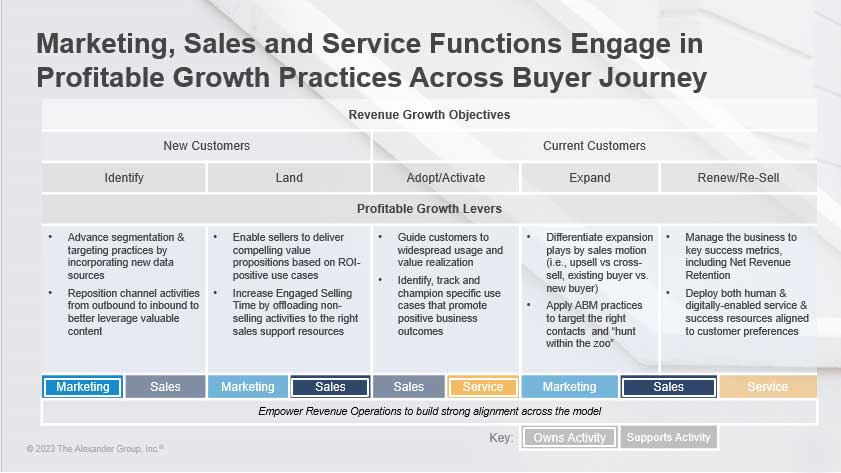The Modern Marketing Organization
Profitable growth companies continually evaluate the effectiveness of their investments, especially Marketing. Leading Marketing organizations demonstrate yield on investment by monitoring the interconnections of KPIs from reach-to-response and results-to-return. Alexander Group research shows that 68% of Modern Marketing Organizations can track Marketing-attributable revenue. As a result, 84% of companies plan to increase their marketing investments in 2023 (with primary investments in digital marketing), and demonstrated results show high performers have 2% improved Marketing Expense/Revenue.
Underlying these results is the growth of specific priorities for the Modern Marketing Organization. Priorities include tracking Return on Marketing Investment (ROMI), leveraging data and aligning functions and roles. Specific profitable growth actions include:
ROMI – Being intentional to measure and drive high Return on Marketing Investment, achieving 6-7X return by using best practices.
Data – Assess the integrity and actionability of first-party data, improve data sharing with partners and create clear buyer personas.
Role Alignment – Refocus on inbound marketing from outbound marketing to leverage valuable, relevant content. Incorporate digital lead generation teams, deemed the most effective worthwhile investment, based on Alexander Group previous research.
Modern Marketing is more than brand awareness or MarCom. This approach focuses on the individual contact level, providing metrics that help sellers sell better. The Marketing organization collects data and insights on target accounts, aligning with sales for desired outcomes. This approach relies extensively on digital marketing, which is why many companies prioritize digital roles and tools as a top investment.
In addition, while growth depends on acquiring new logos and retaining revenue, lead generation supports both efforts. Insights reveal not only potential new customers, but also if current customers believe the manufacturer or distributor provides value. Manufacturers and distributors cannot wait to discover that they no longer have their customer’s business, and advanced insights can help teams proactively address potential problems.
Aligning Sales Teams
Salesforce productivity is critical for profitable growth, with high performers driving both productivity and efficiency. These leaders experienced 1.8X higher revenue per seller, with 4.5% more sellers at or above quota. The lower expense-to-revenue is also a hallmark, with profitable growth leaders incurring a 2% lower expense-to-revenue percent while having a 2.1X higher gross margin per seller. Compensation cost is 1 point lower compared to peers.
Priorities for an efficient, high-growth sales organization include:
Client-centric – Focus on customer needs, not just selling products, resulting in 3 point higher share of the revenue from diversified offerings while collaborating with Service to drive expansion selling.
Revenue Operations (RevOps) – Leaders use RevOps to drive Sales, Marketing and Service integration, with high-performers deeming RevOps a high priority. Top investors in RevOps have 20 points better Net Revenue Retention and have nearly 1/3 more sellers at or above quota.
Profitable growth manufacturers and distributors incorporate RevOps to enable sellers with insights, focus and the right technology. RevOps can take on different structures, depending on the organizational maturity, structure and investment. Nascent companies with fragmented sales operations functions may be starting its journey with RevOps. However, mature companies with well-defined RevOps functions understand and track its value and are strategically investing in people, processes and technology to drive better results out this function.
Compensation – Top companies use strategic compensation design to drive desired outcomes, focusing on growth, not volume.
Compensation is one of the most important motivating tools for the sales force. In fact, approximately 60% of sales expense is compensation. That said, ensuring a motived sales team is not just a problem solved by throwing money at the problem. Modern sales teams understand the connectivity between pay and performance. Top-performing organizations understand today’s sellers are note merely coin-operated; these organizations cultivate a culture driven by purpose, they provide a clear focus and insights to help seller deliver higher value to their customers. So, understanding how you optimize the remaining 40% investment in training, enablement and technology is essential for profitable growth.




